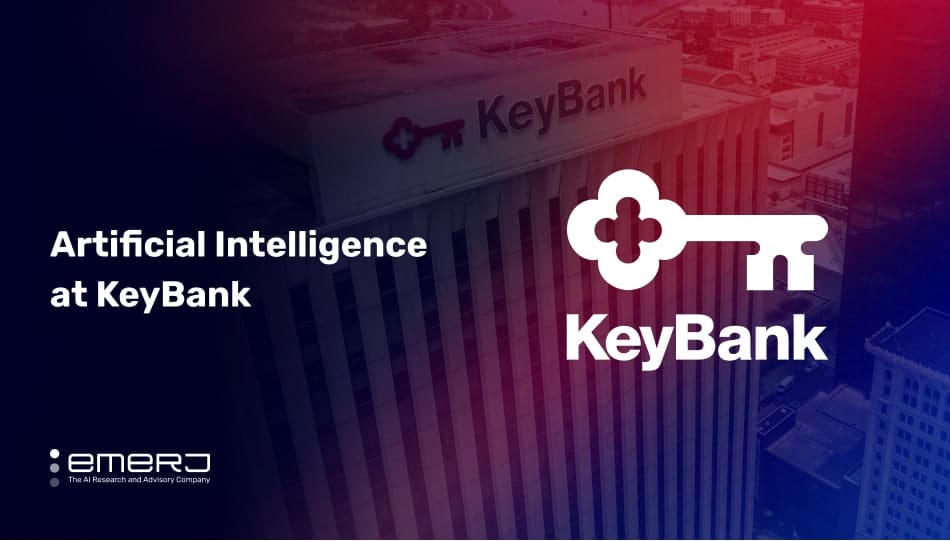KeyBank is a financial services institution with a rich history dating back to 1825 and headquartered in Cleveland, Ohio. With 17,000 employees, operations across 15 states, and assets totaling $187 billion, KeyBank’s commitment to innovation is evident in its strategic application of AI technologies to enhance both workforce management and customer service.
Rather than jump to incorporate Generative AI into already proven user experiences, the Enterprise Center of Excellence for AI and Chat Capabilities team at KeyBank has been hard at work implementing the technology in a way that’s integrated and scalable inside the house first. This strategic alignment has been crucial in overcoming the challenges associated with AI deployment, particularly in managing the naturally siloed arrangements of functions within the bank. Additionally, projects like the Future Ready initiative have created a culture of continuous learning.
By fostering collaboration between different departments, KeyBank has created a cohesive approach to AI adoption. These strategic developments have led to numerous successful applications in critical areas such as employee retention, training, and reskilling, as well as improving customer service outcomes with tools that increase productivity and efficiency compared to traditional technologies.
This article provides an overview of how KeyBank employs AI internally to improve outcomes in two strategic areas:
- Increasing employee retention and intra-company mobility with AI: Using models refined with machine learning and expert human feedback to identify current employees who are best fit for new opportunities within the enterprise, regardless of skill qualifications.
- Using conversational AI to improve customer service outcomes: MyKey helps customer service agents in real-time by providing financial knowledge context surrounding the conversation and summarizing, improving productivity, reducing overall call volume, and keeping headcount low.
Increasing Employee Retention and Intra-Company Mobility with AI
Much of the recent AI hype, particularly in legacy industries like banking, suggests that back-office efficiencies will threaten many white-collar jobs with low turnover. A survey by the Society for Human Resource Management and the Burning Glass Institute, highlighted by The New York Times, indicates financial services will be hit hardest, as AI can streamline tasks like market analysis and predictive modeling.
While AI may create new opportunities, pessimism prevails. KPMG’s latest banking industry outlook survey found that 48 of 200 banking executives expect headcount reductions over the next year despite promises of new AI-driven opportunities.
By embracing and strategically aligning AI and continuous learning initiatives, much of KeyBank’s public messaging on AI-related workforce challenges touts a proactive approach to talent management. To address the evolving dynamics of the workforce and increasing competition, the company partnered with Fuel50, an AI-driven talent marketplace, to revolutionize its approach to employee retention and internal mobility.
In terms of specific AI capabilities, the Fuel50 website mentions a “human-machine teaming” that drives the “best in Ethical Artificial Intelligence” in its systems. While underneath considerable marketing jargon, the language indicates that Fuel50 develops its tools using a combination of machine learning and humans integrated into the process to provide extra verification for output data.
These processes are often referred to as reinforcement learning from human feedback (RHLF). Behind even the most impressive AI systems are large numbers of people working in the RHLF process to label the data needed to make these foundational models powerful for both quality control and human preferences.
KeyBank has been tracking workforce changes and job disruptions since 2017, recognizing the need to stay ahead in the competitive talent landscape.
According to case study documentation from Fuel50, citing KeyBank SVP & Chief Learning Officer Carole Torres as a source, the bank needed a modern approach to align employees, enhance engagement, and ensure retention while preparing for future job disruptions. The challenge was not just to compete with other banks but also to attract and retain top talent from various industries, including tech.
Human resource teams traditionally handle in-house hiring, especially for internal promotions, often using manual workflows. However, AI is now being integrated into HR processes across all sectors.
A recent survey by the Society of Human Resources Management found that one in four HR professionals already uses AI, and adoption is becoming more common in large organizations (5,000+ employees) within the tech, finance, and information industries. Without centralized systems, ad hoc hiring can lack coordination and miss significant opportunities, especially in financial services.
For KeyBank and its partnership with Fuel50, the integrated enterprise solution came in the form of “Future Ready at KeyBank,” an initiative designed to drive workforce change through employee engagement and manager support. The centerpiece of this initiative is “Grow at Key,” powered by Fuel50’s AI opportunity marketplace solution. The platform provides employees with insights into their personal values, skill sets, and the available opportunities within the organization that are best suited to them.
According to marketing materials, such as this one-pager, Fuel50 makes the following claims about their AI Talent Marketplace platform:
- Hyper-Personalization: Employees can develop their distinctive career profiles within Fuel50 and experience a marketplace tailored to their experience and stated goals.
- Talent Mobility & Workforce Planning: Through software integrations and other relative software offerings, including their career journeys solution, users can gain in-depth talent insights, design effective teams, manage talent pipelines, and enhance succession planning and redeployment strategies.
The following video, under a minute in length, gives a glance at the capabilities and dashboard of the platform:
Analyzing a few still images taken from the video showing various dashboards in the Talent Management platform deduces a number of outputs and functions for the management side of the application:
- Self-assessing based on singular and “inferred” talents for potential applicants.
- What percentage of a workforce requested at least one talent validation, and what percentage were received?
The video also displays a number of functions that apply to manager- and employee-based talent workflows:
- Talents in demand ranked by interest.
- Business unit interaction based on talent validation.
- Percentage of talents assessed based on self-assessment and feedback.
Finally, the video displays the following functions for distinctly employee-based talent workflows:
- A ‘career journey’ dashboard that displays an employee’s possible match with possible internal positions.
- Matches are placed in categories of high, medium, low, and “wild card.”
- Pairs users with career coaches from across the enterprise.
- A general marketplace for open positions within the enterprise.
The above features, as displayed in the video, show talent workflows that minimize reliance on interpersonal interactions in the enterprise between employees, managers, and talent professionals to fulfill employee ambitions. This helps center the enterprise’s goals and accommodations for those ambitions first before the employee seeks outside means (e.g., Upwork, LinkedIn).
The Fuel50 case documentation also cites KeyBank EVP and Chief Information Officer Dean Kontul as verifying that the system was designed to be “employee-led and manager-supported” to ensure employees were at the center of system development. We can infer from that characterization that the system was designed to enable primary users (in this case, the employees) to deliver inputs and provide expert feedback to the model.
By using Fuel50, KeyBank has created a common framework for many diverse workforce development efforts, leading to increased employee engagement, talent retention, and internal mobility. Employees are empowered to take ownership of their career growth, leveraging the platform to upskill and reskill for future job opportunities.
The implementation of Fuel50 yielded impressive results:
- 72% user return rate for Grow at Key
- 9,858 skills assessed under the Future Ready initiative
- 100% increase** in participation in the Aspiring Leaders Program
- 60% increase in training participation and usage
- 2,774 upskilling/reskilling actions initiated to close skills gaps
These results underscore the success of KeyBank’s proactive approach to workforce management, positioning the bank to remain competitive for both employees and clients. By fostering a culture of continuous learning and providing employees with the tools they need to succeed, KeyBank has created an environment where talent can thrive.
Using Conversational AI to Improve Customer Service Outcomes
Throughout the financial services industry, conversational AI is primarily seen as the future of customer interactions.
“AI virtual assistants and chatbots allow consumers to complete simple banking tasks without needing to visit a physical location or call a customer service line, getting them the information they need quickly and efficiently,” Managing Director of Digital Product Management at Bank of America Jorge Camargo told PYMNTS in a recent interview. He went on to mention that 98% of BoA customers get their inquiries answered by the bank’s virtual assistant, Erica.
In a recent interview with Emerj on the ‘AI in Business’ Podcast, Dr. Tenushree Luke – then Head of Artificial Intelligence at US Bank – made it clear that these applications cannot be surface-level:
“You cannot think of it just building out a chatbot. You can think of it as an integrated system within a larger servicing either front end back end. But you’re not just looking at natural language processing, you’re also potentially looking at a chat bot potentially also looking at the virtual assistant in combination. You’re also potentially looking at recommendation systems or fraud detection system KYC.”
– Dr. Tanushree Luke, Head of Artificial Intelligence at US Bank
In addition to transforming its workforce, KeyBank has also focused on enhancing customer service through the deployment of conversational AI. Despite the widespread use of AI in the financial sector, many institutions need help with broad implementation and coherent long-term strategies. KeyBank faced similar challenges, particularly in deploying AI to improve customer service while managing costs, maintaining efficiency, and providing a delightful experience.
KeyBank’s approach to AI deployment involved starting small and identifying pilot scenarios that could grow in complexity over time. This strategy was essential in managing the risks associated with AI adoption and ensuring that the technology could deliver tangible benefits.
Overview of KeyBank’s Data/AI Journey (Source: KeyBank‘s Innovative Approach to Recommender Systems)
To address these challenges, KeyBank developed “MyKey,” a conversational AI assistant built using Google’s AI technology. Launched in September 2022, MyKey was initially tested internally before being rolled out live. This digital assistant helps customer service agents by providing real-time financial knowledge, summarizing conversations, and improving productivity.
In terms of user experience, the features displayed in the video for the profile of MyKey available on the KeyBank front page offer the following insights into the application’s capabilities:
Full integration with KeyBank’s online banking features in a seamless mobile application allows users to engage with their checking, savings, credit card, and mortgage accounts through prompts and text.
Screenshot of the MyKey demo video. (Source: KeyBank)
These prompts can vary, but the application’s advertised capabilities claim the assistant can handle queries from “lost my debit card” to “pay back friends” (which defaults to a Zelle-based direct payment function). If the application cannot understand or help with a direct inquiry from the client, the video claims MyKey will automatically route the user to a chat with a human agent.
It also features a main page that largely mirrors the user interface of KeyBank’s online banking desktop application, including full integrations with – what KeyBanks claims – are the following functions:
- Check deposit
- Making transactions
- Managing credit cards and payments
- Finding account & routing numbers
- Locating local branches
- Ordering checks
Screenshot of the MyKey demo video. (Source: KeyBank)
By reducing the need for manual intervention or logging on to the desktop application, KeyBank claims that MyKey enhances contact center efficiency and customer experience. Instead of removing the human element that provides a personal touch to the interaction, KeyBank’s efforts focused on improving the efficiency, accuracy, and productivity of the customer service agents.
The results of these claims are corroborated by specific metrics cited in and testimonials given by senior leadership to industry publications. I
According to Dean Kontul, Chief Information Officer for Voice and Chat Automation and Contact Center Delivery at KeyBank, in an interview with The Financial Brand, the company hired a dedicated team specializing in product, technology, analytics, and conversational design. This team was crucial in ensuring that the AI technology was seamlessly integrated into KeyBank’s existing systems and processes without any costly disruptions to ongoing operations.
The results of adopting MyKey were as follows:
- ~3,000 daily sessions with MyKey in the first month
- 250,000 interactions logged
- 84% containment rate, solving customer problems within the app
These early results demonstrate significant cost savings and improved service efficiency. As Amy Brady, KeyBank’s CIO, told The Wall Street Journal, “We probably hired less because we have less call volume.” She further explained that she believes AI can influence workforce size by increasing worker efficiency, which allows companies to save money by achieving more with fewer employees.






















